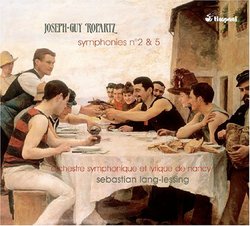| All Artists: Ropartz, Sym Lyrique De Nancy, Lang-Lessing Title: Symphony Nos 2 & 5 Members Wishing: 0 Total Copies: 0 Label: Timpani Original Release Date: 1/1/2006 Re-Release Date: 7/25/2006 Album Type: Import Genre: Classical Style: Symphonies Number of Discs: 1 SwapaCD Credits: 1 UPCs: 675754922825, 3377891310974 |
Search - Ropartz, Sym Lyrique De Nancy, Lang-Lessing :: Symphony Nos 2 & 5
 | Ropartz, Sym Lyrique De Nancy, Lang-Lessing Symphony Nos 2 & 5 Genre: Classical
|
Larger Image |
CD Details |
CD ReviewsVive le compositeur! Thomas F. Bertonneau | Oswego, NY United States | 12/01/2006 (5 out of 5 stars) "Guy Ropartz was a Breton symphonist who, with his fellow Breton Charles Tournemire, adapted the principles of César Franck's "Schola Cantorum" to the regional ethos of Brittany. Like Franck, Tournemire and Ropartz were devoutly Catholic and rather more mystical than ritual in their disposition. Tournemire's symphonies appeared on the Marco Polo label in the 1990s and some are still available. Ropartz has until now been only sparsely recorded. In the late 1980s, Michel Plasson led a performance of the Third Symphony (1905), for chorus and orchestra, with his Toulouse forces, which EMI issued in the United States. Now the courageous Timpani label has begun issuing an integral set of Ropartz's orchestral music, including the six symphonies and the Petite Symphonie. The performers are Sebastian Lang-Lessing (conductor) and the Orchestre Symphonique et Lyrique de Nancy. Ropartz was a long-time director of the Conservatory at Nancy, so that there is a link (if, at this late date, only a sentimental one) between the performers and the composer. This review covers Volume II of the symphonies, featuring Symphonies Nos. 2 and 5.
Ropartz belongs firmly to the César Franck or "Schola Cantorum" tradition of the French Symphony; the model of his symphonies - as of those by Vincent D'Indy, Ernest Chausson, Albéric Magnard, or Ropartz's fellow Breton Charles Tournemire - is Franck's D-Minor Symphony (1888). The "Pater Seraphicus," as his students called Franck, under the influence of Liszt's "Faust" Symphony, wrote in his D-Minor essay in three movements heavily chromatic in their harmonic language and using a "cyclic" compositional plan whereby the thematic material for all three sections derives from basic motifs exposed in the first bars of the work as a whole. Ropartz's Symphony No. 1 had adhered closely to this pattern, being composed "on a Breton chorale." An implication of the specifically Breton cast of Symphony No. 1 is that the work has a programmatic character depicting the locale and its associated ethos. While the composer stipulated no specific source for the basic material of Symphony No. 2 (1899 - 1900), he nevertheless cuts it from the same regional cloth as Symphony No. 1. Now, however, Ropartz casts his work in the usual four movements rather than as a Franck-inspired triptych. As Haydn did for many of his symphonies, Ropartz furnishes his First Movement with a slow Introduction, all in minor-key counterpoint with plastic phrasing. The fast music develops the aria-like motifs of the Introduction as a vigorous Allegro. The following Scherzo or Second Movement is brief and vigorous; it is more rustic than anything in Symphony No. 1 despite No. 1's topographic designation. Those who know the scherzo-movement of Magnard's Symphony No. 3 will have some idea of it. The Third (Slow) Movement begins with a Sibelius-like passage for strings. Listeners will be reminded alternately of Sibelius and Franck. The Fourth Movement (Finale) recapitulates the fervor of the First-Movement Allegro, recalling the "cyclic" motifs introduced at the beginning of the score. Symphony No. 5 comes from much later in Ropartz's career - from the mid-1940s. Yet the style, while leaner, has not altered much. As in Symphony No. 2 there are four movements. The thematic material is fresh. "Beautiful" and "serious" are good words to describe the simultaneous aspects of Ropartz's orchestral music. The performances by conductor Sebastian Lang-Lessing with the Orchestre Symphonique et Lyrique de Nancy are utterly convinced and utterly convincing; the recording is also top-flight, with excellent foregrounding of solo work when appropriate and a good three-dimensional sound picture. I look forward to the completion of Ropartz's symphonic series by these performers." |

 Track Listings (8) - Disc #1
Track Listings (8) - Disc #1